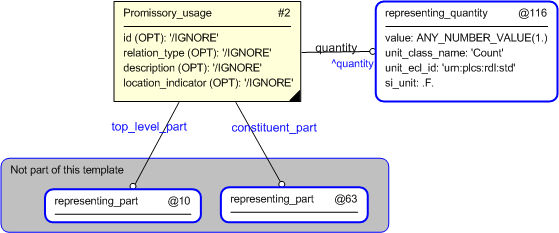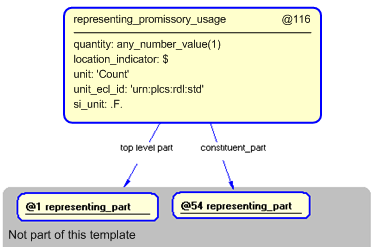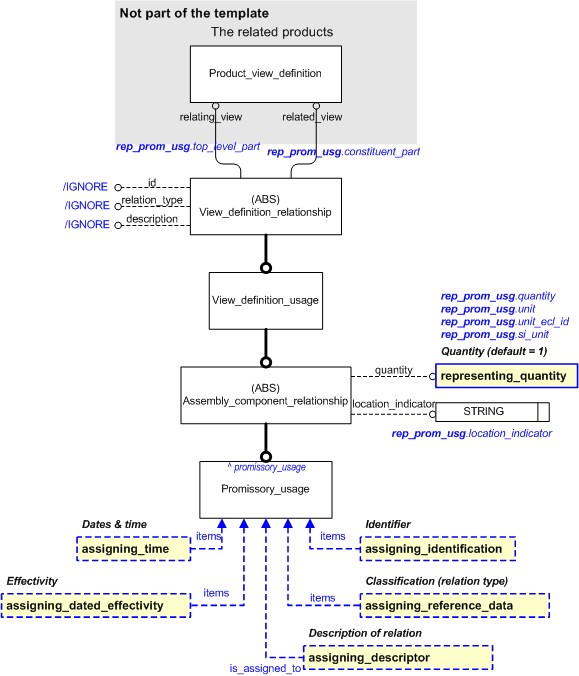| Template:— representing_promissory_usage (rep_prom_usg) |
Date: 2008/03/01 19:23:45
Revision: 1.19
|
This section specifies the template representing_promissory_usage.
NOTE
An explanation of a template and the associated instantiation path is
provided in the
Template overview
section.
This template describes how to represent a promissory usage relationship between components and some higher-level assembly
that is not the immediate parent in the hierarchy. This template is specifically targeted at Part_view_definition(s) that
occur within the design stage of an assembly structure. From a usage context, it may be important to relate an outsourced
component to a top-level assembly definition related to a configuration and product concept. A supplier may not need to know
the detailed assembly structure in between. The promissory component usage may be useful during early design phases to create
preliminary BOMs for prototyping.
The EXPRESS-G diagram in
Figure
1
shows the templates and EXPRESS entities that are required
to represent the template
"representing_promissory_usage".
The text highlighted in blue shows the template parameters.
The EXPRESS-G diagram shows the inheritance hierarchy for the entity Promissory_usage. The templates supporting
the values which are ignored in a typical PLCS implementation are either given explicitly (as part of this template), or implicitly
through optional templates which provide non-essential infomation. As the attributes are inherited by Promissory_usage, so
it is infered that the templates are similarly applied.
Figure 1 — An EXPRESS-G representation of the Information model for representing_promissory_usage
The graphic for the template to be used in other EXPRESS-G diagrams
is shown in Figure
2
below.
Figure 2 — The graphical representation of the representing_promissory_usage template
The following input parameters are defined for this template:
The relating view definition
The related view definition
The quantity of the child in parent assembly. If unspecified, '1' is assumed.
A string indicating the location of the child in the parent, e.g. right wing.
unit (Default=Count,Type='CLASS')
The name of the class used to represent the units of the corresponding quantity.
The following classes and their sub-classes can be used:
The identifier of the
External_class_library
storing the definition of the class referenced by the parameter @unit.
si_unit (Default=.F.,Type='BOOLEAN')
Value should be set to true if the unit is a SI base unit defined by ISO, i.e.
kilogram (kg) for Mass,
second (s) for Time,
metre (m) for Displacement,
ampere (A) for Electrical current,
kelvin (K) for Temperature,
mole (mol) for Amount of substance, and
candela (cd) for Luminous intensity. If this is not the case it should be set to false.
Note that the representation of true and false depends on exchange format. In Part 11 (a STEP file) true is
represented by the string ".T.", and false by ".F.", while in Part 28 (XML) they are represented by text strings "true"
and "false".
The following reference parameters are defined for this template:
Allow the
Promissory_usage
entity instantiated in this path to be referenced when this template is used.
%^target = $representing_promissory_usage.promissory_usage%
The instantiation path shown below specifies the entities that are to be
instantiated by the template.
The following entities are instantiated with attributes as specified:
The instance diagram in Figure
3
shows an example of the EXPRESS entities and templates that are instantiated by the template:
/representing_promissory_usage(top_level_part='#10', constituent_part='#63', quantity='ANY_NUMBER_VALUE(1)', location_indicator='$', unit='Count', unit_ecl_id='urn:plcs:rdl:std', si_unit='.F.')/
(an illustration of the consolidated representing_promissory_usage template is shown in
Figure
4 below.)
Figure 3 — Entities instantiated by representing_promissory_usage template
The instance diagram in
Figure
4
shows the graphic symbol for the template that is to be
used in other instance diagrams. The example template is:
/representing_promissory_usage(top_level_part='#10', constituent_part='#63', quantity='ANY_NUMBER_VALUE(1)', location_indicator='$', unit='Count', unit_ecl_id='urn:plcs:rdl:std', si_unit='.F.')/
Figure 4 — Instantiation of representing_promissory_usage template
The following section details how the
representing_promissory_usage
template can be optionally characterized by assigning
other constructs to it. These are characterizations commonly
applied to the template. The ISO 10303-239 EXPRESS model may enable
other assignments to the entities instantiated by the template.
The EXPRESS-G diagram in Figure
5
shows the possible characterizations of the template
"representing_promissory_usage".
Figure 5 — Characterizations of the representing_assembly_structure template
The following characterizations may apply:
Characterization Assigning date and time
NOTE this characterization is optional.
The Promissory_usage
may be assigned a date and time, e.g. to indicate when it was created.
Such a time-stamp shall be used to infer dated effectivity for the assembly structure,
but if that is the reason, it is recommended that effectivity as described below, shall be used instead.
A date and time is assigned to a
Promissory_usage
using assigning_time. If only the date is desired, the time parameters shall be set to "0".
The date and time shall be classified using a subclass of
"Date_actual"
(urn:plcs:rdl:std:Date_actual)
or
"Date_planned"
(urn:plcs:rdl:std:Date_planned).
NOTE
The assignment of date and time information is described the capability C036: assigning_date_time (NB Capabilities are not documented in this release of the PLCS standard)
.
Characterization Assigning effectivity
NOTE this characterization is optional.
An effectivity may be assigned to the Promissory_usage.
This shall be done using entity Effectivity_assignment.
For example, a dated effectivity is assigned using template assigning_dated_effectivity.
NOTE
The assignment of effectivities are described in capability C006: assigning_effectivity (NB Capabilities are not documented in this release of the PLCS standard)
.
Characterization Assigning descriptor
NOTE this characterization is optional.
A description of the relationship may be provided using the template assigning_descriptor.
This shall be applied to the ^promissory_usage reference parameter. The following template call shows how this shall
be instantiated.
/assigning_descriptor(descr='This relationship relates any constituent parts to a top level item', class_name='Description', ecl_id='urn:plcs:rdl:std', is_assigned_to='@1')/
NOTE
The assignment of description information is described the capability C095: assigning_descriptor (NB Capabilities are not documented in this release of the PLCS standard)
.
Characterization Assigning identification
NOTE this characterization is optional.
An identification of the relationship may be provided using the template assigning_identification.
This shall be applied to the ^promissory_usage reference parameter.
The following template call shows how this shall be instantiated.
/assigning_identification(id='PRUS-PVD-001-001', class_name='Promissory_usage_code', ecl_id='urn:plcs:rdl:std', org_id='Parts R Us', org_id_class_name='Organization_name', org_ecl_id='urn:plcs:rdl:std', items='@1')/
NOTE
The assignment of date and time information is described the capability C001: assigning_identifiers (NB Capabilities are not documented in this release of the PLCS standard)
.
Characterization Assigning reference data
NOTE this characterization is optional.
The
Promissory_usage
may be classified by using the template
assigning_reference_data.
This shall be applied to the ^promissory_usage reference parameter.
NOTE
The assignment of date and time information is described the capability C010: assigning_reference_data (NB Capabilities are not documented in this release of the PLCS standard)
.





